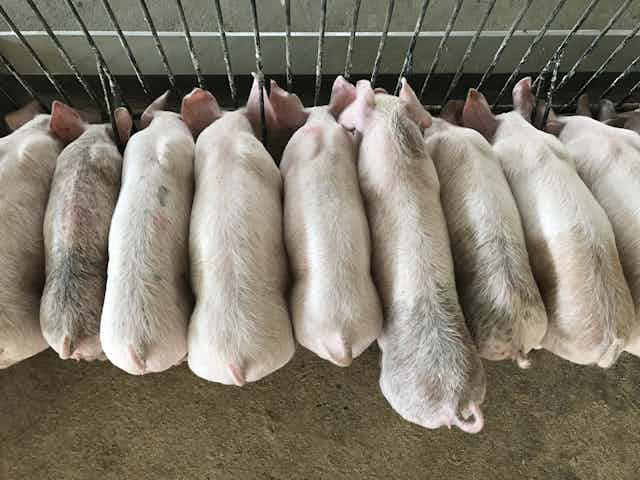In the spring of 2001, the UK countryside turned into a crematorium. A foul-smelling haze settled over parts of the country as 6m cows, sheep, pigs and goats were slaughtered and their carcasses burned in the fields. This was the result of a bid to control an outbreak of foot-and-mouth disease – a contagious disease of livestock named after the ulcers it causes in the mouth and between the hooves of farm animals.
The outbreak began on Burnside farm, Northumberland, where uncooked swill – food leftovers – were illegally fed to a barn of pigs. Under the regulation at the time, food wastes had to be cooked to sterilise them and prevent disease-transfer. This was the first step in a series of unfortunate events which led to the costliest animal epidemic the country had ever seen.
Unknown to the farmer, that unprocessed food waste contained imported meat infected with the foot-and-mouth virus. Once it was introduced the virus spread across the country, exacerbated by a slow response from the Ministry for Agriculture, Fisheries and Food (which was later rebranded as DEFRA, in an effort to move on from the debacle). The ministry’s efforts to limit livestock movements were ultimately too little too late. In the aftermath of the outbreak, the government had to do something, and so the use of all food wastes in animal feed was banned (irrespective of heat-treatment), ending the 9,000-year-old practice of swill-feeding. This UK-wide ban was extended to the EU within a year.
But 17 years on, a growing body of research is questioning whether the ban on swill was the right response for farmers, pigs, and the planet.

The value of swill
The European livestock industry, in many ways, is in a squeeze. The emergence of large-scale commercial livestock farming operations in the world’s rapidly developing economies has increased the international competition for animal feeds, driving up feed prices and shrinking profits. This is compounded by the bad press that surrounds the use of soybeans, the archetypal modern animal feed ingredient, demonised for its role in deforestation in the forests and savannahs of Latin America. Media headlines criticising the livestock sector for its impact on the environment are becoming all too familiar – on a finite planet with a growing population, some argue it is an unacceptable waste of resources to grow grains to feed livestock instead of people.
It is in light of these challenges that interest in swill has been rekindled. Legalising heat-treated swill once more would put livestock back at the heart of a sustainable food system, a green, circular economy where livestock play a key role in recycling nutrients and disposing of food waste. Indeed, when compared with turning food waste into biogas or compost, using it as swill is hands-down the option with the lowest environmental impact.

And it can be done – in the same year that the UK banned the use of swill, Japan introduced the opposite policy, establishing a modern, regulated system for safely producing swill. Today, countries like Japan and South Korea recycle around 40% of their food waste as animal feed.
Farmers use swill not because of its environmental benefits, but because it reduces their feed costs by 40-60%. They have achieved these remarkable results through a science-based approach to swill feeding; swill manufacturers in Japan and South Korea must be registered and their compliance with food safety regulation is monitored. Food wastes are treated for three minutes at 80°C, or 30 minutes at 70°C – both enough to deactivate viruses such as foot-and-mouth. Since the introduction of these regulated systems, no disease outbreaks have been associated with swill feeding in these countries.
Modern European swill
The potential in Europe is huge. Recent research suggests that if Europe were to recycle food waste as swill on the scale achieved in East Asia, this would reduce the land required to produce pig feed by 20%. This an area the size of Wales, including more than a quarter of a million hectares of Latin American soybeans.
For Europe to mimic the success of these East Asian systems requires first and foremost the development of safe operating systems for the European context, based on the regulated heat-treatment and production of swill.

Importantly, legalising swill would require the right level of enforcement to ensure it is done safely. There should arguably be zero tolerance for people caught bending the rules – in stark contrast with the Ministry for Agriculture, Fisheries and Food’s softly-softly approach, which facilitated the 2001 foot-and-mouth outbreak (a MAFF inspector even visited the farm where the outbreak occurred two weeks beforehand, but didn’t clamp down on the farm’s questionable practices). And when weighing up the risks and benefits of reintroducing swill, we also must not forget the risks of the current “ban”, which is frequently broken – a survey of smallholder UK pig farmers for example found that a quarter of them feed uncooked food wastes to their pigs.
All of this would, of course, be irrelevant if farmers weren’t willing to use swill. But a new study conducted at the UK’s largest pig industry trade-fair shows that 75% of pig farmers and other attendees of the event supported its relegalisation, and half of all pig farmers surveyed said they would consider using swill on their farm.

Support was not unanimous – some people were understandably concerned about disease risks and consumer acceptance of swill. But overall, the level of support for swill was similar to other alternative animal feeds, such as much-hyped insects.
As the meat industry battles to clean up an image tarnished by environmental impacts, questions over animal welfare, and food safety scandals, swill remains a good news story rarely told. A key question to all in the sector is how livestock products can be repositioned as a sustainable part of people’s diets, reared in ways that respect traditional farming practices, with high food safety.
Well, perhaps where there’s swill, there’s a way.

